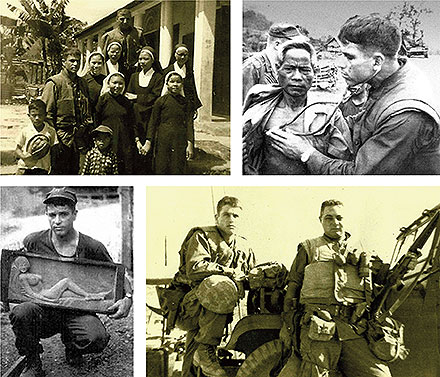 |
||||||||||||
|
November/December 2014
BY MIKE BRIAN
“I was well read and knew the Vietnam War was a lost cause before I even got there,” he says. “It was insanity.” After a few months in the relative safety of Da Nang Air Base, Miller’s commanding officers realized he was “a bit cantankerous” and not a career officer. So they shipped him to Dong Ha near the DMZ to serve out the rest of his time. By the time he was medevaced out eight months later with a temperature of 105 degrees, Miller had served in Con Thien, Khe Sanh, and The Rock Pile. Miller’s focus was treating wounded and dying Marines, but when an opportunity arose to treat civilians, he would organize a MedCAP—a medical civil action program—working with Marine volunteers who would go with him into villages for security. Quickly, though, his commanders forbade the use of U.S. medical supplies on civilians. So Miller began scavenging for medical supplies, soliciting help from some of his physician friends in Da Nang, and buying supplies with money he raised from woodcarvings of Playboy bunnies that he created himself and sold to the highest bidder. “Helping civilians was different than doing my job. It was a choice,” Miller says. “MedCAPs were the only sane things in the midst of insanity.” They gave him a connection with his own humanity, he says, and he was even more motivated after that enemy soldier spared his life. When he returned to the U.S., Miller set up a medical practice, first in California then in Huntsville, Alabama. But his desire to provide care to the underserved never went away. In the early 1980s Miller and his wife Lynne volunteered with the St. Louis-based Wings of Hope, an organization that brought medical care to Mexico and parts of Central America. “My wife would fly me into a village, drop me off, and I’d stay for three or four days delivering babies and helping people,” Miller says. For some ten years they made stops in Mexico, Guatemala, El Salvador, and Costa Rica. Miller gives much of the credit for a lifetime of helping people to Navy Corpsman Mel Overmeyer, who asked Miller to go on his first MedCAP. “While I was still working in the hospital in Da Nang, he said, ‘Come on out to our territory,’ and I did. My life hasn’t been the same since,” says Miller. His friend Overmeyer, while treating wounded Marines during an NVA siege near Con Thien, was severely wounded by grenade shrapnel and suffered head trauma that left him paralyzed on one side. His actions earned him the Silver Star.
|
||||||||||||
|
|
||||||||||||
|
||||||||||||
8719 Colesville Road, Suite 100, Silver Spring. MD 20910 | www.vva.org | contact us |
||||||||||||










 ohn Miller—a member of VVA’s Tucson Chapter 106—was born in the backwoods of Idaho on a subsistence farm near the Canadian border. By the time he completed his medical training at UCLA courtesy of the U.S. Navy, he was already in his late twenties.
ohn Miller—a member of VVA’s Tucson Chapter 106—was born in the backwoods of Idaho on a subsistence farm near the Canadian border. By the time he completed his medical training at UCLA courtesy of the U.S. Navy, he was already in his late twenties.